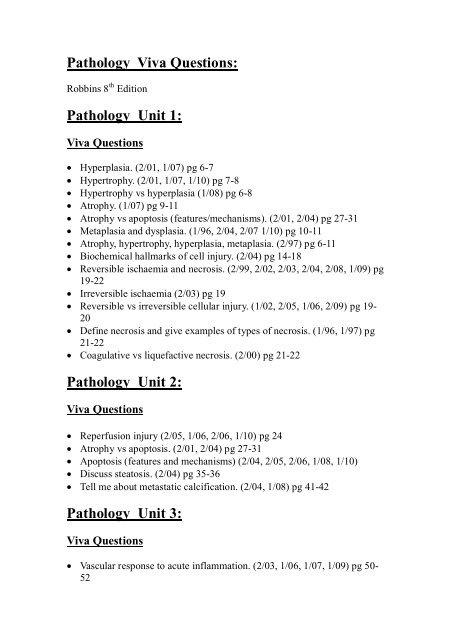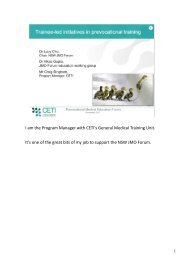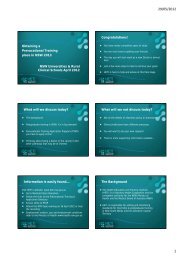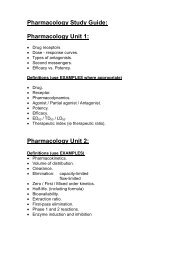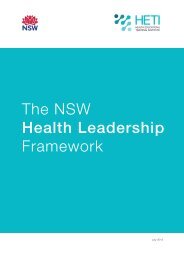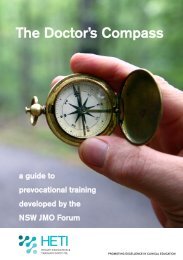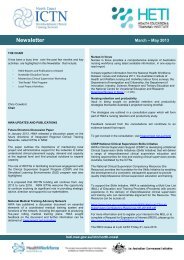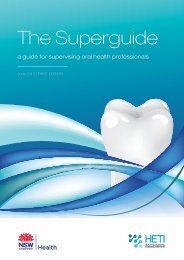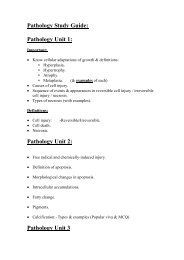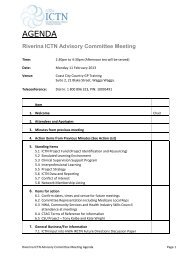Pathology Viva Questions: Pathology Unit 1: Pathology Unit 2 ... - HETI
Pathology Viva Questions: Pathology Unit 1: Pathology Unit 2 ... - HETI
Pathology Viva Questions: Pathology Unit 1: Pathology Unit 2 ... - HETI
You also want an ePaper? Increase the reach of your titles
YUMPU automatically turns print PDFs into web optimized ePapers that Google loves.
<strong>Pathology</strong> <strong>Viva</strong> <strong>Questions</strong>:<br />
Robbins 8 th Edition<br />
<strong>Pathology</strong> <strong>Unit</strong> 1:<br />
<strong>Viva</strong> <strong>Questions</strong><br />
Hyperplasia. (2/01, 1/07) pg 6-7<br />
Hypertrophy. (2/01, 1/07, 1/10) pg 7-8<br />
Hypertrophy vs hyperplasia (1/08) pg 6-8<br />
Atrophy. (1/07) pg 9-11<br />
Atrophy vs apoptosis (features/mechanisms). (2/01, 2/04) pg 27-31<br />
Metaplasia and dysplasia. (1/96, 2/04, 2/07 1/10) pg 10-11<br />
Atrophy, hypertrophy, hyperplasia, metaplasia. (2/97) pg 6-11<br />
Biochemical hallmarks of cell injury. (2/04) pg 14-18<br />
<br />
Reversible ischaemia and necrosis. (2/99, 2/02, 2/03, 2/04, 2/08, 1/09) pg<br />
19-22<br />
Irreversible ischaemia (2/03) pg 19<br />
Reversible vs irreversible cellular injury. (1/02, 2/05, 1/06, 2/09) pg 19-<br />
20<br />
Define necrosis and give examples of types of necrosis. (1/96, 1/97) pg<br />
21-22<br />
Coagulative vs liquefactive necrosis. (2/00) pg 21-22<br />
<strong>Pathology</strong> <strong>Unit</strong> 2:<br />
<strong>Viva</strong> <strong>Questions</strong><br />
Reperfusion injury (2/05, 1/06, 2/06, 1/10) pg 24<br />
Atrophy vs apoptosis. (2/01, 2/04) pg 27-31<br />
Apoptosis (features and mechanisms) (2/04, 2/05, 2/06, 1/08, 1/10)<br />
Discuss steatosis. (2/04) pg 35-36<br />
Tell me about metastatic calcification. (2/04, 1/08) pg 41-42<br />
<strong>Pathology</strong> <strong>Unit</strong> 3:<br />
<strong>Viva</strong> <strong>Questions</strong><br />
Vascular response to acute inflammation. (2/03, 1/06, 1/07, 1/09) pg 50-<br />
52
Role of neutrophils in acute inflammation. (1/96, 1/01, 2/08) pg 53-61<br />
Chemical mediators of inflammation. (2/95, 1/99, 2/02) pg 63-74<br />
Role of the complement system in host defence. (1/02, 2/06, 2/08) pg 64<br />
<strong>Pathology</strong> <strong>Unit</strong> 4:<br />
<strong>Viva</strong> <strong>Questions</strong><br />
Tell me about chronic inflammation. (1/98, 2/07, 2/09) pg 78-81<br />
Tell me about the role of macrophages. (1/95) pg 79-81<br />
<strong>Pathology</strong> <strong>Unit</strong> 5:<br />
<strong>Viva</strong> <strong>Questions</strong><br />
Angiogenesis. (2/04, 1/08) pg 99-102<br />
Tell me about wound healing by primary intention. (86, 2/93, 1/95, 1/98,<br />
2/98, 2/02, 1/04, 2/04, 1/05, 1/07, 2/09) pg 102-106<br />
<br />
Tell me about wound healing by secondary intention. How does this<br />
differ from primary union (1/02) pg 102<br />
What are the complications of wound healing (2/93) pg 106<br />
What pathological factors could affect wound healing (1/00, 2/08, 1/10)<br />
pg 106-108<br />
Explain the mechanism of scar formation and fibrosis. (2/04, 1/05, 1/08)<br />
pg 104, 107<br />
<strong>Pathology</strong> <strong>Unit</strong> 6:<br />
Revision Week<br />
<strong>Pathology</strong> <strong>Unit</strong> 7:<br />
<strong>Viva</strong> <strong>Questions</strong><br />
<br />
Pathogenesis of oedema. (1/93, 2/98, 2/99, 1/02, 1/03, 1/07, 1/10) pg<br />
120-122<br />
Ascites. (2/95) pg 120<br />
Normal haemostasis. (1985, 2/09)<br />
Role of platelets in coagulation. (2/99, 2/03, 1/05, 2/06, 1/09) pg 126-127<br />
Clotting cascade:
Discuss this. (1/95, 2/99, 1/05, 2/06, 1/10) pg 127-130<br />
Discuss factors that inhibit the cascade. (2/03) pg 125<br />
Venous thrombosis:<br />
Predisposing factors and outcomes. (1/96, 1/97, 1/01, 1/04, 1/05, 1/09)<br />
pg 133<br />
Pathogenesis. (2/99, 2/02, 2/06) pg 130-132<br />
Effects of arterial thrombosis. (1/01) pg 133, pg 135<br />
Embolism: sources and consequences. (2/95, 1/97, 1/99, 1/08, 2/09) pg<br />
136-137<br />
Cellular pathology of irreversible shock. (2/97) pg 141-142<br />
Pathogenesis of septic shock. (2/97, 2/00, 2/05, 2/07, 1/09) pg 140<br />
Haemorrhagic shock. (2/99, 1/03) pg 141<br />
<strong>Pathology</strong> <strong>Unit</strong> 8:<br />
<strong>Viva</strong> <strong>Questions</strong><br />
Cells of the immune system. (2/96) pg 196-202<br />
T-cells. (1/00, 2/00) pg 196-198<br />
B-cells (1/01, 1/03) pg 198-199<br />
Role of complement in immune processes. (1/03) pg 210<br />
Hypersensitivity. (1/95) pg 205<br />
Type 1 hypersensitivity. pg 206-209<br />
Explain. (1/98, 1/99, 2/00, 2/07, 2/09)<br />
Chemical mediators and their actions. (1/02) pg 208<br />
Type 2 hypersensitivity (transfusion reaction). (1/99, 2/00, 1/01, 2/05,<br />
2/08, 1/10) pg 210<br />
Type 3 hypersensitivity. (2/99, 2/03, 2/05, 2/08) pg 211-214<br />
Type 4 hypersensitivity. (2/99, 2/07, 1/09) pg 215-218<br />
<strong>Pathology</strong> <strong>Unit</strong> 9:<br />
<strong>Viva</strong> <strong>Questions</strong><br />
HIV virus and modes of transmission. (1/01, 2/03) pg 236-238<br />
Immunopathogenesis of AIDS. (1/96, 2/99) pg 238-243<br />
Abnormalities of immune function in AIDS. (2/98) pg 242 table 6-12
<strong>Pathology</strong> <strong>Unit</strong> 10:<br />
<strong>Viva</strong> <strong>Questions</strong><br />
Describe the pathogenesis of atherosclerosis. (1/95, 2/99, 1/01, 2/01,<br />
1/03, 2/08) pg 521-524<br />
What are the microscopic features of an atheroma (1/00) pg 517<br />
Tell me about the pathogenesis of essential hypertension. (2/01) pg 526-<br />
529<br />
Tell me about aneurysms. (1/95) pg 530-531<br />
Aortic aneurysms:<br />
Pathogenesis (1/04) pg 531<br />
Complications (2/04) pg 532<br />
What is an aortic dissection (2/04, 1/07, 1/10) pg 532-534<br />
<strong>Pathology</strong> <strong>Unit</strong> 11:<br />
<strong>Viva</strong> <strong>Questions</strong><br />
Pathophysiology of acute pulmonary oedema. (1/96) pg 562<br />
Tell me about the pathogenesis of MI. (2/98, 1/99, 1/00, 2/01, 2/07) pg<br />
576-577<br />
What are the pathological consequences of acute MI (2/03) pg 584-586<br />
Tell me about cardiogenic shock. (1/98) pg 584<br />
<strong>Pathology</strong> <strong>Unit</strong> 12:<br />
<strong>Viva</strong> <strong>Questions</strong><br />
Tell me about hypertensive heart disease. (1/03) pg 587<br />
Tell me about calcific aortic stenosis. (2/04, 2/08) pg 590-591<br />
Infective endocarditis:<br />
Pathogenesis. (2/00, 2/02) pg 596-597<br />
What are the potential organ system effects (2/00) pg 597<br />
Describe the pathogenesis of acute pericarditis. (2/03, 2/08) pg 611-612<br />
Hypertrophic cardiomyopathy (1/06, 1/09) pg 604-606<br />
<strong>Pathology</strong> <strong>Unit</strong> 13:<br />
Revision Week
<strong>Pathology</strong> <strong>Unit</strong> 14:<br />
<strong>Viva</strong> <strong>Questions</strong>:<br />
Outline the differences between benign and malignant tumours. (1/95,<br />
1/97, 2/99) pg 281<br />
Tumour invasion and metastases. (1/05, 1/09) pg 279-281<br />
Invasion of the extracelluar matrix. (1/05) pg 310-313<br />
What clinical effects may tumours have on their host (2/09) pg 332-335<br />
Tell me about paraneoplastic syndromes. (1/05) pg 333-335<br />
What are tumour markers (+examples).<br />
Which agents are thought to be carcinogenic <br />
<strong>Pathology</strong> <strong>Unit</strong> 15:<br />
<strong>Viva</strong> <strong>Questions</strong><br />
Tell me about host barriers to infection. (2/95, 2/09) pg pg 352-353<br />
Describe how viruses cause cell injury. (1/02) pg 356-357<br />
Describe how bacteria cause cell injury. (1/02) pg 357-359<br />
Measles. (1/07) pg 363<br />
Herpes simplex. (1/07) pg 365-366<br />
Varicella zoster. (2/01, 2/05, 1/06) pg 368<br />
Tell me about staphylococcal infections. (2/95, 2/99) pg 371-372<br />
Tell me about streptococcal infections. (1/96, 1/00, 1/04, 2/09) pg 373-<br />
374<br />
<strong>Pathology</strong> <strong>Unit</strong> 16:<br />
<strong>Viva</strong> <strong>Questions</strong><br />
Neisserial infections. (1/09) pg 377-378<br />
Tell me about infection with M. tuberculosis. (1/05, 2/08) pg 381-386<br />
Pathogenesis of primary pulmonary TB (2/98, 2/03) pg 381-382<br />
Anareobic bacterial infection. (2/99)<br />
Discuss clostridial wound infections. (1/01, 1/04) pg 393-394<br />
Clostridial infections. (1/08) pg 393-394<br />
Tell me about tetanus. (1/95, 2/98)<br />
Candidiasis. (2/08) pg 397-398
Clinical effects of malaria (2/01) pg 401-402<br />
Pathogenesis of malaria (2/03, 2/08) pg 401-402<br />
Describe the pathogenesis of plasmodium falciparum infection. (2/03)<br />
<strong>Pathology</strong> <strong>Unit</strong> 17:<br />
<strong>Viva</strong> <strong>Questions</strong><br />
Name the main constituents of tobacco smoke, and their effects on<br />
health. (1/01) pg 419-420<br />
Discuss the pathological effects of smoking on the lung. (2/03) pg 419-<br />
420<br />
Discuss the pathological consequences of heroin use. (2/03) pg 426<br />
What are the patterns of lung injury related to air pollution (2/97) pg<br />
429<br />
Lead poisoning (2/06) pg 432-433<br />
Tell me about radiation injury. (1/95, 2/97, 2/03, 2/06) pg 436-441<br />
Tell me about the systemic consequences of a thermal burn. (2/95) pg<br />
445<br />
Vitamin K (1/09) pg 456<br />
Thiamine deficiency (2/06) pg 456-457<br />
<strong>Pathology</strong> <strong>Unit</strong> 18:<br />
Revision Week<br />
<strong>Pathology</strong> <strong>Unit</strong> 19:<br />
<strong>Viva</strong> <strong>Questions</strong><br />
Tell me about the causes of ARF. (2/96) pg 960-961<br />
Post streptococcal glomerulonephritis. (1/06, 2/06) pg 974-976<br />
Nephrotic syndrome. (2/06, 1/08) pg 978-979<br />
<br />
Describe the pathological changes in the kidney in acute tubular necrosis.<br />
(1/00, 1/02, 1/06) pg 993-996<br />
What is the pathogenesis of pyelonephritis (1/99, 2/00) pg 998-1000<br />
Analgesic abuse nephropathy (2/00) pg 1003-1004<br />
Describe the pathogenesis of hypertensive renal failure. (2/96) pg 1007-<br />
1008<br />
Obstructive uropathy. (1/00) pg 1012-1014<br />
Renal calculi:
Pathogenesis of kidney stones. (1/95, 1/99, 2/02, 1/06, 2/07) pg 1014<br />
Consequences. (1/99, 2/02) pg 1015<br />
<strong>Pathology</strong> <strong>Unit</strong> 20:<br />
<strong>Viva</strong> <strong>Questions</strong><br />
Types of atelectasis, pg 713-714<br />
What are the causes of ARDS (2/96, 1/01, 1/04, 2/09) pg 715<br />
Emphysema:<br />
Basic pathology of emphysema. (1/97, 2/00, 1/06, 1/07, 2/07, 1/10)<br />
pg 717-722<br />
Pathological classifications. (1/97, 2/98) pg 718-719<br />
Pathogenesis of chronic bronchitis. (1/99) pg 722<br />
Asthma:<br />
Pathogenesis. (2/96, 1/98, 1/02, 1/06, 1/07) pg 723-724<br />
Pathological features. (1/04) pg 726<br />
Basic pathological processes of restrictive lung disease. (1/97) pg 729<br />
<strong>Pathology</strong> <strong>Unit</strong> 21:<br />
<strong>Viva</strong> <strong>Questions</strong><br />
Pathogenesis of pulmonary embolism. (1/98, 1/00, 2/02) pg 742<br />
Bacterial pneumonia. (1/99, 2/99, 2/00) pg 748-749<br />
Legionella pneumonia. (1/01, 2/02, 1/05) pg 749<br />
Atypical pneumonia (1/03) pg 751-752<br />
Influenza (1/05, 1/09, 1/10) pg 751-752<br />
Malignant mesothelioma (1/09) pg 768-769<br />
<strong>Pathology</strong> <strong>Unit</strong> 22:<br />
<strong>Viva</strong> <strong>Questions</strong><br />
Peptic ulcer disease (1/08) pg 816-819<br />
Bacterial enteritis. (2/01, 2/02, 2/04) pg 833-834<br />
Salmonella dysentery (2/04, 1/06) pg 835<br />
Cholera (2/04, 1/06) pg 835-836<br />
Crohns disease (2/05, 1/09) pg 847-849<br />
Ulcerative colitis (2/05) pg 849-851<br />
Ischaemic bowel disease (2/05, 2/09) pg 851-853
<strong>Pathology</strong> <strong>Unit</strong> 23:<br />
<strong>Viva</strong> questions:<br />
Cirrhosis:<br />
Basic pathological principles (1/97, 1/05) pg 882-883<br />
Pathophysiology of the consequences. (1/97) pg 883<br />
Portal hypertension. (1/05, 1/10) pg 883-885<br />
Mechanisms involved in the formation of ascites. (1987, 2/95)<br />
Tell me about unconjugated jaundice. (2/97, 2/98, 2/99, 2/00) pg 887<br />
Hepatitis A (2/05, 1/08) pg 890-891<br />
Hepatitis B infection.<br />
Describe the serological changes (1/92, 1/96, 1/97, 2/98, 1/04) pg 893<br />
Pathogenesis (1/97, 2/98) pg 892<br />
Clinical syndromes, pathological consequences. (1/97, 2/02, 2/05)<br />
<br />
Hepatitis C<br />
Tell me about the pathogenesis. (1/00, 2/01, 2/02, 1/08) pg 894<br />
Consequences. (2/02, 2/06, 1/09) pg 895<br />
Hepatitis D (2/06, 1/10) pg 895-896<br />
Pathogenesis of chronic viral hepatitis. (2/01) 898-899<br />
Pathogenesis of fulminant hepatitis. (2/01) pg 899-901<br />
Alcoholic hepatitis and consequences. (2/02, 1/07) pg 904-907<br />
Cholelithiasis – pathogenesis and consequences. (2/02, 1/07) pg 928-931<br />
<strong>Pathology</strong> <strong>Unit</strong> 24:<br />
Revision Week<br />
<strong>Pathology</strong> <strong>Unit</strong> 25:<br />
<strong>Viva</strong> <strong>Questions</strong><br />
<br />
Leukopaenia:<br />
Pathological causes (1/97)<br />
Immunological consequences (1/97)
<strong>Pathology</strong> <strong>Unit</strong> 26:<br />
<strong>Viva</strong> <strong>Questions</strong><br />
Tell me about acute pancreatitis. Consequences. (2/96, 1/98, 2/02, 1/04,<br />
1/05, 2/06, 2/09) pg 942-944<br />
What are the complications of chronic pancreatitis (2/96) pg 945-946<br />
<strong>Pathology</strong> <strong>Unit</strong> 27:<br />
<strong>Viva</strong> <strong>Questions</strong><br />
Tell me about the causes of anaemia. (2/95) pg 623<br />
Discuss the pathological basis of haemolytic anaemia. (1/97, 1/99, 1/10)<br />
pg 624-625<br />
Sickle cell anaemia (1/08) pg 628-632<br />
Pernicious anaemia (2/06) pg 639-642<br />
Tell me about microcytic anaemia. (2/97) pg 643-646<br />
Von Willebrands disease (2/07, 1/09) pg 655<br />
Haemophilia A (2/07) pg 655<br />
Tell me about DIC. (2/00) pg 656-657<br />
Pathogenesis of DIC. (2/03, 1/08, 2/09) pg 656-658<br />
<strong>Pathology</strong> <strong>Unit</strong> 28:<br />
<strong>Viva</strong> <strong>Questions</strong><br />
Fracture healing:<br />
Sequence of events. (1/96, 2/98, 2/00, 2/01, 1/03, 1/05, 2/07) pg 1288-<br />
1289<br />
Pathological processes affecting (2/02) pg 1289<br />
Avascular necrosis. (2/01) pg 1289-1290<br />
Tell me about osteoarthritis. (1/98, 2/05) pg 1304-1305<br />
Rheumatoid arthritis (2/05) pg 1305-1308<br />
OA versus RA. (2/01) pg 1304-1308<br />
Tell me about gout. (2/05, 1/08) pg 1311-1314
<strong>Pathology</strong> <strong>Unit</strong> 29:<br />
<strong>Viva</strong> <strong>Questions</strong><br />
Pituitary adenoma (2/08)<br />
Hyperthyroidism (2/97, 2/08)<br />
Graves disease. (1/06)<br />
Thyroiditis. (2/98)<br />
Pathogenesis of Type 1 DM. (1/98, 1/06, 2/08, 2/09)<br />
Pathogenesis of Type 2 DM. (1/06)<br />
<strong>Pathology</strong> <strong>Unit</strong> 30:<br />
Revision Week<br />
<strong>Pathology</strong> <strong>Unit</strong> 31:<br />
<strong>Viva</strong> <strong>Questions</strong><br />
Peripheral nerve transaction and repair. (2/98, 2/00, 1/03) pg 1330<br />
<strong>Pathology</strong> <strong>Unit</strong> 32:<br />
<strong>Viva</strong> <strong>Questions</strong><br />
Non haemorrhagic CVA (2/07) pg 1363-1365<br />
Subarachnoid haemorrhage (1/07) pg 1366-1367<br />
Ruptured berry aneurysm (2/07) pg 1367<br />
Bacterial meningitis. (2/00, 1/07, 1/10) pg 1369-1370<br />
Non bacterial meningitis. (1/03) pg 1370<br />
Multiple sclerosis (1/07, 2/09) pg 1382-1384<br />
Alzheimers disease (2/07) pg 1386-1389<br />
<strong>Pathology</strong> <strong>Unit</strong> 33:<br />
<strong>Viva</strong> <strong>Questions</strong><br />
Pre-eclampsia. ( 1/08)


